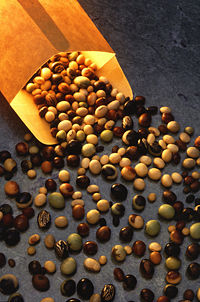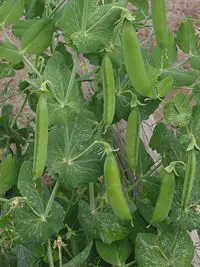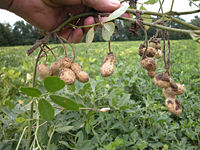Difference between revisions of "Legume" - New World Encyclopedia
| Line 3: | Line 3: | ||
[[Image:Doperwt rijserwt peulen Pisum sativum.jpg|thumb|200px|right|Pea pods]] | [[Image:Doperwt rijserwt peulen Pisum sativum.jpg|thumb|200px|right|Pea pods]] | ||
| − | + | '''Legumes''' are members of the ''Fabaceae'' (also called ''Leguminosae'') family of [[flowering plants]]. They are one of the largest plant families and include [[bean]]s, [[pea]]s, [[peanut]]s, lupins, alfalfa, clover, and many others. | |
| − | + | The word "legume" can also refer to the type of [[fruit]] which is characteristic of most of them. A legume in this sense is a ''simple dry fruit'' which develops from a simple ''[[carpel]]'' and usually ''dehisces'' (opens along a seam) on two sides. A common name for this type of fruit is a "pod", although pod is also applied to a few other fruit types. | |
| − | |||
| − | |||
Legumes are noteworthy for their ability to [[nitrogen fixation|fix atmospheric nitrogen]], an accomplishment attributable to a [[symbiotic]] relationship with certain bacteria known as [[rhizobia]] found in [[root nodules]] of these plants. The ability to form this symbiosis reduces [[fertilizer]] costs for farmers and gardeners who grow legumes, and means that legumes can be used in a [[crop rotation]] to replenish soil that has been depleted of [[nitrogen]]. | Legumes are noteworthy for their ability to [[nitrogen fixation|fix atmospheric nitrogen]], an accomplishment attributable to a [[symbiotic]] relationship with certain bacteria known as [[rhizobia]] found in [[root nodules]] of these plants. The ability to form this symbiosis reduces [[fertilizer]] costs for farmers and gardeners who grow legumes, and means that legumes can be used in a [[crop rotation]] to replenish soil that has been depleted of [[nitrogen]]. | ||
| − | Legume seed and foliage has a comparatively higher [[protein]] content than non-legume material, probably due to the additional nitrogen that legumes receive through nitrogen-fixation symbiosis. This high protein content makes them | + | Legume seed and foliage has a comparatively higher [[protein]] content than non-legume material, probably due to the additional nitrogen that legumes receive through nitrogen-fixation symbiosis. This high protein content makes them an important food both for people and for animals. |
Farmed legumes fall into two classes: [[forage]] and [[cereal|grain]]. | Farmed legumes fall into two classes: [[forage]] and [[cereal|grain]]. | ||
| Line 17: | Line 15: | ||
* Grain legumes are cultivated for their [[seed]]s, and are also called [[pulse (legume)|pulse]]s. The seeds are used for human and animal consumption or for the production of oils for industrial uses. Grain legumes include [[bean]]s, [[lentil]]s, [[lupin]]s, [[pea]]s and [[peanut]]s. | * Grain legumes are cultivated for their [[seed]]s, and are also called [[pulse (legume)|pulse]]s. The seeds are used for human and animal consumption or for the production of oils for industrial uses. Grain legumes include [[bean]]s, [[lentil]]s, [[lupin]]s, [[pea]]s and [[peanut]]s. | ||
| − | The term is derived from the [[French language|French]] word "légume" (which, however, has a wider meaning and refers to any kind of [[vegetable]]). | + | The term is derived from the [[French language|French]] word "légume" (which, however, has a wider meaning and refers to any kind of [[vegetable]]). The French word comes from the Latin ''legumen'', which means "anything that can be gathered." |
==References== | ==References== | ||
Revision as of 21:15, 28 July 2006
Legumes are members of the Fabaceae (also called Leguminosae) family of flowering plants. They are one of the largest plant families and include beans, peas, peanuts, lupins, alfalfa, clover, and many others.
The word "legume" can also refer to the type of fruit which is characteristic of most of them. A legume in this sense is a simple dry fruit which develops from a simple carpel and usually dehisces (opens along a seam) on two sides. A common name for this type of fruit is a "pod", although pod is also applied to a few other fruit types.
Legumes are noteworthy for their ability to fix atmospheric nitrogen, an accomplishment attributable to a symbiotic relationship with certain bacteria known as rhizobia found in root nodules of these plants. The ability to form this symbiosis reduces fertilizer costs for farmers and gardeners who grow legumes, and means that legumes can be used in a crop rotation to replenish soil that has been depleted of nitrogen.
Legume seed and foliage has a comparatively higher protein content than non-legume material, probably due to the additional nitrogen that legumes receive through nitrogen-fixation symbiosis. This high protein content makes them an important food both for people and for animals.
Farmed legumes fall into two classes: forage and grain.
- Forage legumes, like alfalfa, clover and vetch, are sown in pasture and grazed by livestock.
- Grain legumes are cultivated for their seeds, and are also called pulses. The seeds are used for human and animal consumption or for the production of oils for industrial uses. Grain legumes include beans, lentils, lupins, peas and peanuts.
The term is derived from the French word "légume" (which, however, has a wider meaning and refers to any kind of vegetable). The French word comes from the Latin legumen, which means "anything that can be gathered."
ReferencesISBN links support NWE through referral fees
- European association for grain legume research, Website AEP
- Mediterrasian - Article discussing health benefits of eating legumes
- University of Minnestota, 2003, "Forage Legumes"[1]
Credits
New World Encyclopedia writers and editors rewrote and completed the Wikipedia article in accordance with New World Encyclopedia standards. This article abides by terms of the Creative Commons CC-by-sa 3.0 License (CC-by-sa), which may be used and disseminated with proper attribution. Credit is due under the terms of this license that can reference both the New World Encyclopedia contributors and the selfless volunteer contributors of the Wikimedia Foundation. To cite this article click here for a list of acceptable citing formats.The history of earlier contributions by wikipedians is accessible to researchers here:
The history of this article since it was imported to New World Encyclopedia:
Note: Some restrictions may apply to use of individual images which are separately licensed.


